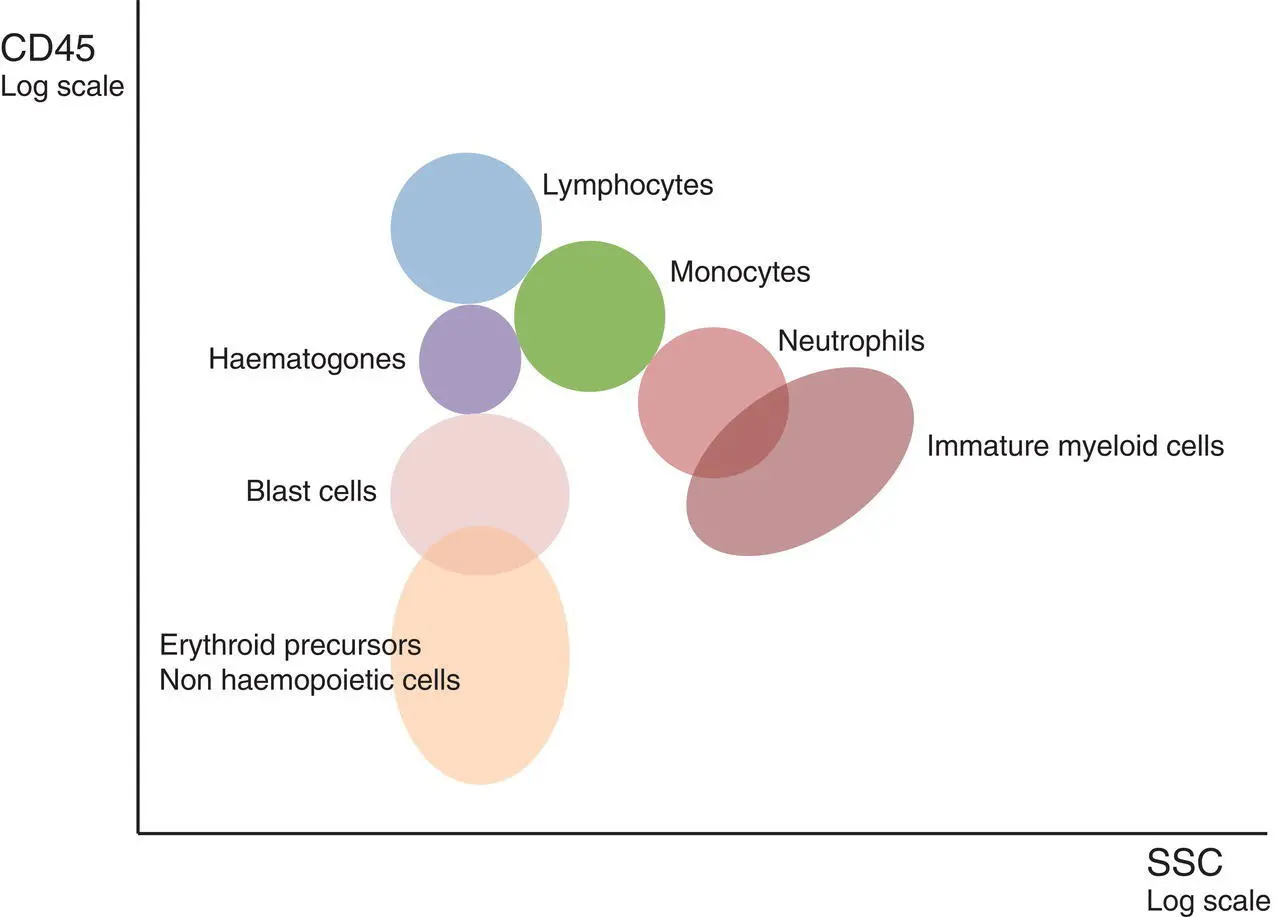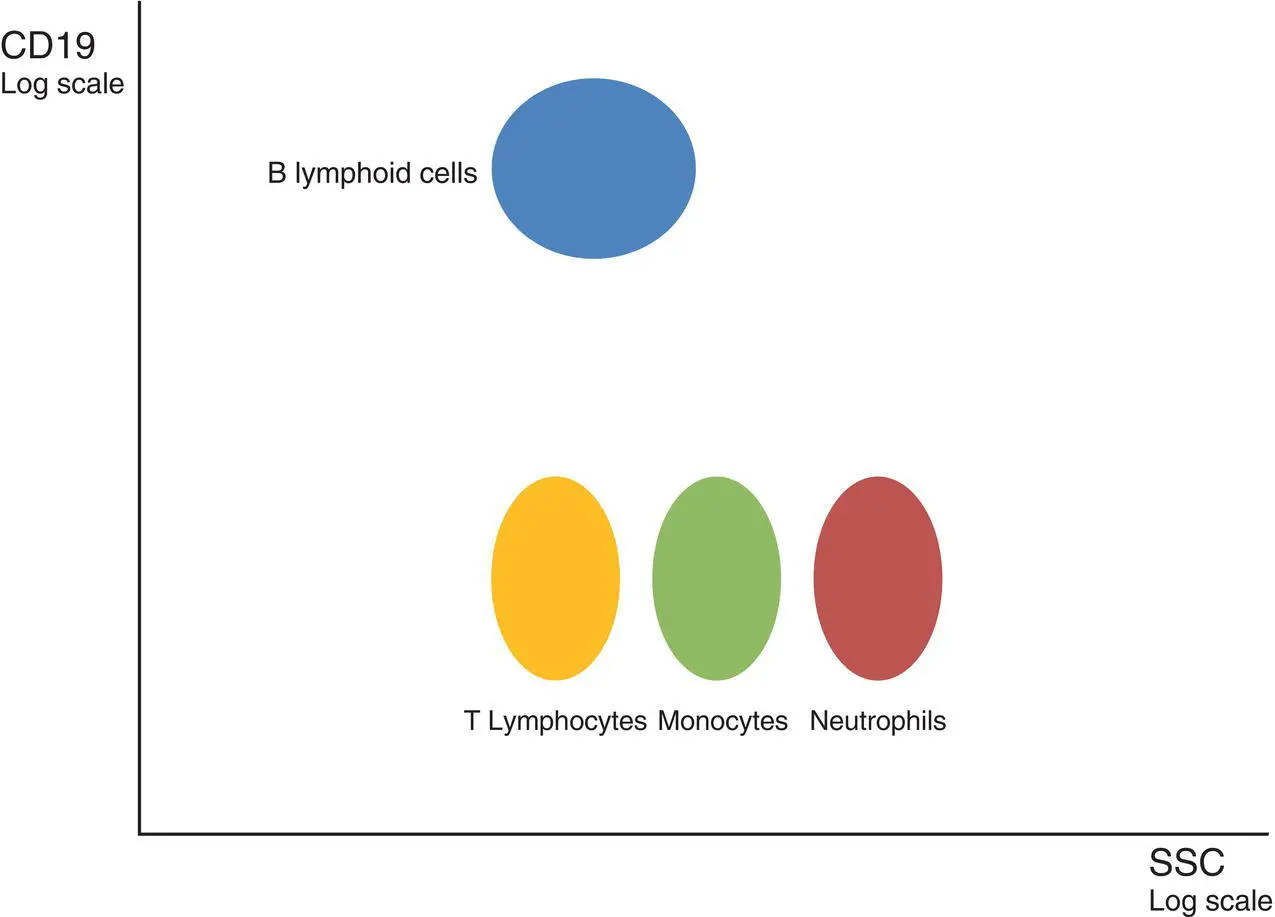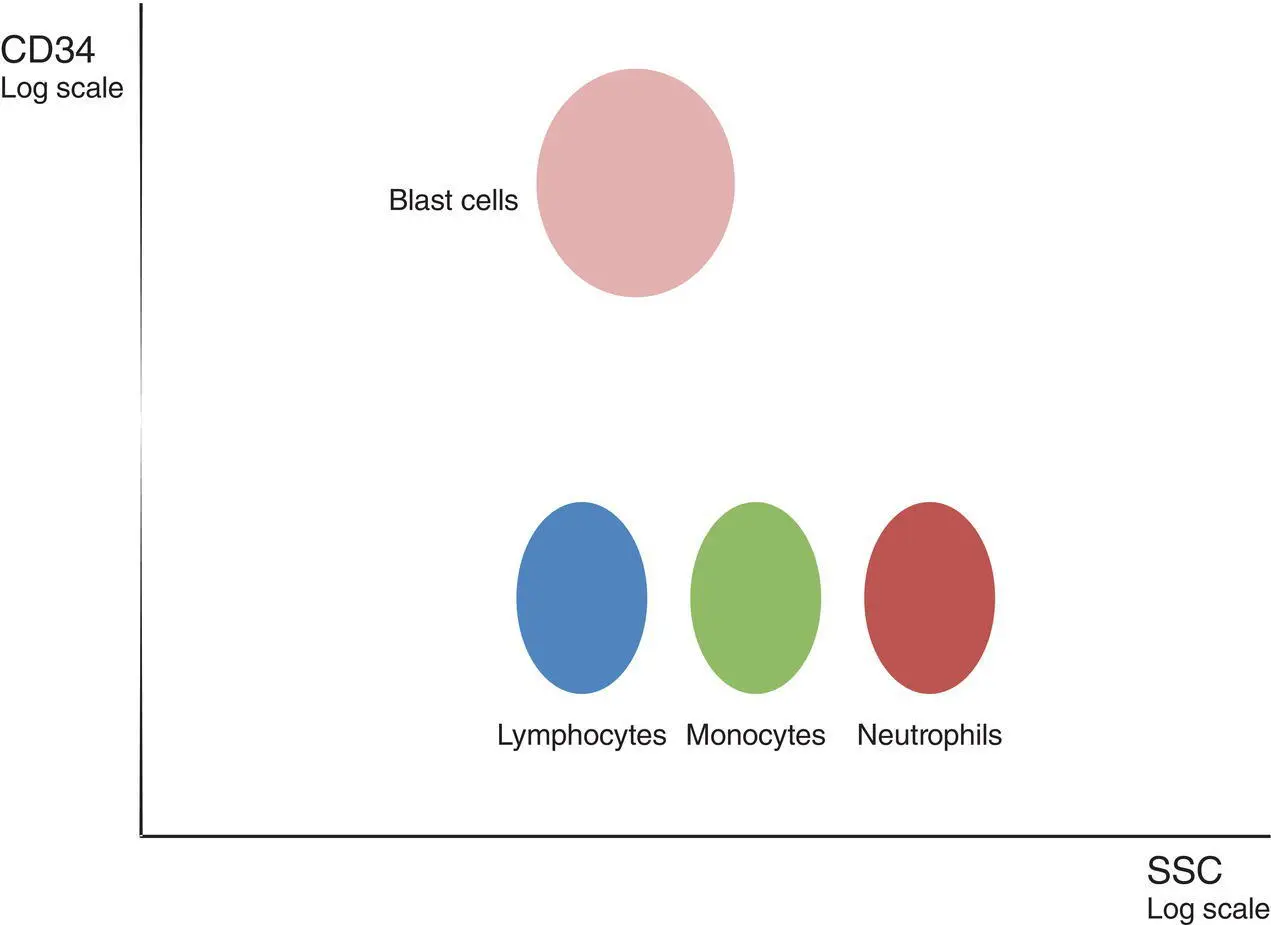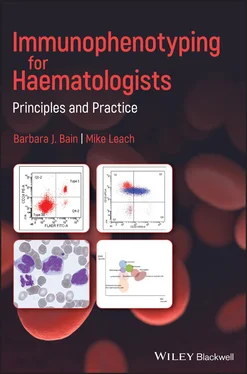
Figure 1.3 Delineation of peripheral blood or bone marrow leucocyte populations using CD45 expression and SSC.
A plot of CD45 expression and SSC is not only useful for separating normal cell populations but also helps identify precursor cell populations, which frequently show only weak CD45 expression ( Figure 1.3).
CD19 versus SSC ( Figure 1.4) and CD34 versus SSC ( Figure 1.5) plots are useful for isolating B cells and blast cells, respectively.
Back gating is a process whereby a target population identified in one approach can be tracked in another. For example, CD34+ myeloblasts can be isolated using CD34 versus SSC, then colour tracked into the FSC versus SSC plot to show cell size and granularity. With modern multichannel instruments it is possible to study 6–8 or more antigens in a single tube. If multiple tubes are studied, several core antibody‐fluorochrome conjugates can be included in each tube analysed so that cross‐comparison between the same cells stained with different antibody panels in different tubes is possible.

Figure 1.4 Delineation of peripheral blood or bone marrow B‐cell populations using CD19 expression and SSC.

Figure 1.5 Delineation of peripheral blood or bone marrow CD34+ blast populations using CD34 expression and SSC.
Flow cytometric immunophenotyping is used particularly in the investigation of haematological neoplasms, but there are other roles ( Table 1.2).
Following analysis, the immunophenotyping laboratory will issue a report detailing the characteristics of any abnormal population identified and offering an interpretation. The strength of expression of any antigen is also of relevance. This may be expressed as
Table 1.2 Role of flow cytometric immunophenotyping.
| Haematological neoplasms |
| Diagnosis of haematological neoplasms |
| Further classification, e.g. of AML, B‐ALL, T‐ALL |
| Identification of disease spread, e.g. to the central nervous system |
| Identification of a therapeutic target, e.g. CD19, CD20, CD30, CD33, CD52 |
| Detection of minimal residual disease (which may include identifying a leukaemia‐specific phenotype at diagnosis) |
| Identification of hypodiploidy and hyperdiploidy in B‐ALL, including the detection of masked hypodiploidy when there has been duplication of a small hypodiploid clone |
| Investigation of erythrocytes and their disorders |
| Diagnosis of paroxysmal nocturnal haemoglobinuria (CD15, CD16, CD24, CD55, CD59, CD66b, CD157, FLAER on neutrophils; CD14, CD55, CD157 and FLAER on monocytes; CD55, CD59 and FLAER on erythrocytes) (reviewed in [1]) |
| Identification of a PNH clone in aplastic anaemia (predictive of better prognosis and a response to immunosuppressive therapy) |
| Diagnosis of hereditary spherocytosis (eosin‐5‐maleimide binding). Binding is also reduced in hereditary pyropoikilocytosis, South‐East Asian ovalocytosis and congenital dyserythropoietic anaemia, type II |
| Diagnosis of hereditary stomatocytosis due to RHAG mutation (reduced expression of CD47, which is part of the Rh protein complex) |
| Detection and enumeration of fetal red cells in maternal circulation (using anti‐RhD when mother is RhD‐positive, or using permeabilised erythrocytes and an antibody to haemoglobin F) or using the two techniques in combination |
| Investigation of platelets and their disorders |
| Diagnosis of inherited platelet disorders: Glanzmann’s thrombasthenia, deficiency of platelet glycoprotein IIb/IIIa (CD41/CD61 absent or reduced in three quarters of patients); Bernard–Soulier syndrome, deficiency of glycoprotein I/V/IX (CD41 and CD42a/CD42b moderately reduced); Scott syndrome (annexin V not expressed on activated platelets); GFI1B mutation (CD34 expressed on platelets); Wiskott–Aldrich syndrome (deficiency of WAS protein, reduced or defective CD43 on T lymphocytes) |
| Investigation of leucocytes and their disorders including investigation of immune function |
| Investigation of suspected primary immunodeficiency syndromes (reviewed in [2]) |
| Diagnosis of autoimmune lymphoproliferative syndrome (CD3+TCRαβ+CD4–CD8– lymphocytes) |
| Diagnosis of leucocyte adhesion deficiencies type I (CD18 and CD11a, 11b and 11c deficient) and type II (CD15s deficient); reduced expression of CD11b, CD18 or CD15s by phorbol esterase‐stimulated neutrophils is demonstrated |
| Diagnosis of neutrophil specific granule deficiency (reduced SSC, CD15, CD16, CD66, myeloperoxidase and lactoferrin) |
| Diagnosis of chronic granulomatous disease using dihydrorhodamine as a marker of H 2O 2production after stimulation of neutrophils; carrier detection is also possible |
| Enumeration of CD4‐positive T cells in HIV infection |
| Investigation for lymphocytic variant of hypereosinophilic syndrome (aberrant phenotypes such as CD3–CD4+CD8– or CD3+CD4–CD8–) |
| Diagnosis of haemophagocytic lymphohistiocytosis (HLH) (upregulation of HLA‐DR on T cells; CD57 and perforin can also be upregulated; testing for deficiency of perforin, SAP, XIAP or CD107a is used to screen for various underlying genetic defects [3, 4] |
| Diagnosis of persistent polyclonal lymphocytosis |
| Identification of hypersensitivity by upregulation of CD63 and CD300a on exposure of basophils to a specific allergen [5] |
| Identification of sepsis by CD64 expression on neutrophils |
| Other |
| Enumeration and isolation of haemopoietic stem cells (CD45 weak, CD34+, SSC low) |
| Differential leucocyte counting; the Beckman Coulter Hematoflow, for example, can distinguish neutrophils, eosinophils, basophils, CD16– and CD16+ monocytes, B cells, CD16+ cytotoxic T cells and NK cells, CD16– T cells, myeloblasts, monoblasts, B lymphoblasts and T lymphoblasts * |
| Enumeration and characterisation of reticulocytes or platelets by the binding of a fluorochrome (e.g. a proprietary mixture of polymethine and oxazine in Sysmex instruments) to RNA or the binding of a fluorescence‐labelled CD61 monoclonal antibody to platelets (CellDyn instruments) * |
AML, acute myeloid leukaemia; B‐ALL, B‐lineage acute lymphoblastic leukaemia; CD, cluster of differentiation; FLAER, fluorescent aerolysin; HIV, human immunodeficiency virus; HLA‐DR, human leucocyte antigen‐DR; PNH, paroxysmal nocturnal haemoglobinuria; RNA, ribonucleic acid; SAP, SLAM‐associated protein; T‐ALL, T‐lineage acute lymphoblastic leukaemia; XIAP, X‐linked inhibitor of apoptosis
*This is not part of conventional immunophenotyping but represents a flow cytometric immunophenotyping technique incorporated into an automated instrument for performing blood counts.
1 –, ±, +, ++;
2 negative, weak, moderate, strong;
3 negative, dim, moderate, bright;
4 hi, lo.
It should be noted that ± indicates weak expression whereas +/– indicates that expression may be positive or negative.
Читать дальше















